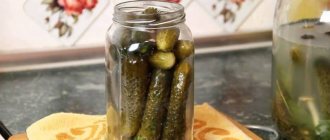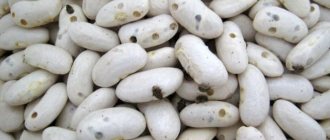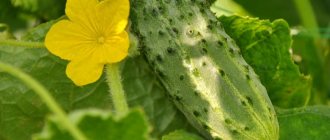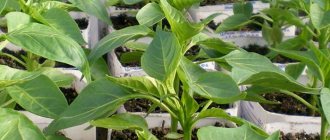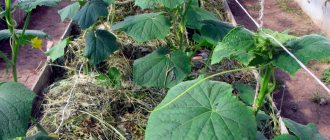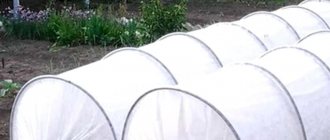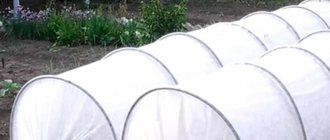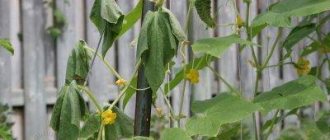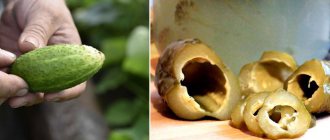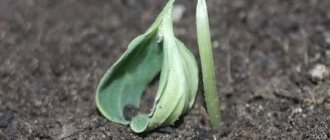Red cucumbers, or Tladiantha dubious
This plant, originally from the Far East, received a second name - red cucumber - due to the similarity of the fruits. Part of the pumpkin family. In its homeland it is considered a rather aggressive weed, capable of growing even in the most unfavorable conditions.
In the photo - Tladianta dubious during the flowering period.
Characteristics and description
Red cucumber is a herbaceous vine with a powerful root system . Young shoots are formed annually from tubers, since the above-ground part dies off with the onset of cold weather. Tubers are not afraid of sub-zero temperatures.
Numerous shoots, foliage, flowers and fruits are covered with hard, dense hairs. Tendrils form on the stems, with the help of which they cling to supports and grow into a continuous green carpet. The main stem reaches a height of 5 m.
The leaves are large (5–10 cm), light green, heart-shaped, with a pointed tip.
The dioecious plant produces male and female flowers, yellow or yellow-green. Male flowers are collected in inflorescences in the form of brushes, have a bell shape and a pronounced color. Female flowers are pale, inexpressive, often solitary, flat in shape, and appear later than male flowers. Ovaries form at the base. Flowering period June – September.
Pollination in the homeland of the crop is carried out by wild bees of the genus Ctenoplectra. Other insects ignore the plant, so in order to survive, it has adapted to vegetative propagation (roots, cuttings). In the conditions of our country, the culture requires painstaking artificial pollination. This can be done using a soft brush or by applying anthers to the pistils. But there is another opinion, according to which, to obtain a harvest, it is enough for the vine to bear male and female flowers.
Important ! Without pollination, red cucumber fruits cannot be obtained.
Appearance and taste
The natural habitat of Tladianta dubious is coastal meadows, sandy deposits of sea coasts, vegetable gardens and orchards.
The green fruits are heavily pubescent; as they ripen, the surface becomes smooth. Ripe fruits are striped, orange or orange-red in color, 2-5 cm in size, and resemble tiny cucumbers in appearance.
Fruiting period July – September. Green fruits have a grassy, fresh taste. They can be used like regular cucumbers. The taste of ripe Tladianta is a mixture of exotic and pumpkin plants, reminiscent of baked pumpkin with a hint of kiwi and pineapple. The pulp is soft, sweet, slightly cottony, and inside contains many seeds in a dense dark shell.
Description of the plant
Tladianta dubious is a perennial vine that is a member of the pumpkin family. It can be found in Europe and North America; it is practically not cultivated in Russia. Latin name: Thladiantha dubia.
Tladianta throws out long lashes that climb to the tops of trees or grow along the walls of houses. Their size reaches 5 meters. A distinctive feature is the formation of tubers on the root system and vines hanging low above the ground. The leaves are broadly ovate, with tomentose pubescence, and shaped like a heart. Length - from 6 to 12 cm, width - from 5 to 10 cm. The culture has male and female bell-shaped flowers located on different plants. The flowering period begins in summer (July) and lasts until September.
The fruits are oval, similar to small cucumbers, which turn red as they ripen. Due to insufficient pollination in central Russia, they are usually seedless. Length – up to 8 cm, diameter – about 2 cm. The pulp is very tender and sweet, but not all people like its taste, so the plant is not used in cooking so often. Thanks to the unusual color of ripe fruits, tladiant became known as the Red Cucumber.
The plant is winter hardy. The tubers tolerate frost well in the soil, and in the spring new shoots grow from them. Therefore, tladianta spreads quite quickly throughout the area. This feature must be taken into account when planting next to other vegetable crops. Some people who grow it in their summer cottage, after a while, wonder how to get rid of it. The young plant is not afraid of frost down to -3°C. The scourge recovers very quickly, and new shoots appear from the tubers.
Reproduction methods: vegetative and seed. However, the latter is not used so often, because bees pollinate flowers very reluctantly. There are more than 25 types of crops, but in the middle zone only one is cultivated - Tladianta dubious.
Composition and nutritional value
The chemical composition of the plant has not been studied in depth, but the following substances were found in it:
- Vitamins of group B, as well as A, C, E.
- Minerals – phosphorus, potassium, calcium, iron, manganese.
- Pectins.
- Alimentary fiber.
- Sahara.
- Enzymes.
During the ripening process, the concentration of carotenoids, anthocyanins and cholcones in fruits increases. It is these substances that give them their red color.
Calorie content – about 15 kcal per 100 g.
Advantages and disadvantages
The dubious advantages of Tladianta include:
- possibility of use for medicinal purposes;
- excellent taste;
- ease of care;
- attractive appearance.
The main disadvantage is the rapid growth . In a few weeks, the vine covers everything around, displacing other plants from the area around the house. Gardeners spend years fighting aggressive crops and are sometimes unable to cope with the lush greenery.
But there is a way out! To protect other plants, slate is dug into the ground around the perimeter of the red cucumber bed to a depth of 40-50 cm. This will stop the roots from spreading throughout the entire area.
Landing technology
In what conditions do red cucumbers grow best? Planting and care are carried out in accordance with certain rules. First of all, you should choose a place. Tladianta loves the sun, so it will grow well on the south side of the site. Gardeners have noticed that this plant also does well in partial shade.
Tladianta cannot be called a capricious plant, but you still need to know some of the features of its cultivation. Let's take a closer look at all the stages.
Choosing a place
- Flower growers prefer to plant this vine on the south or south-east side of the site. The plant loves sun and warmth. It is not advisable to plant in places where there is dampness, drafts or north winds.
- Red cucumber grows well in partial shade, under the crown of tall trees, under the roofs of buildings.
- When planting, immediately install a root limiter, since during the summer season the plant can grow several meters to the sides.
Tladianta grows on different soils, even poor ones. But it is preferable to plant on loose and light soil
It is important that the required amount of oxygen and moisture reaches the root system
The liana grows especially well on loams. It is recommended to regularly moisten the soil, especially in hot and dry weather.
Agricultural technology
Red cucumber is grown in two ways: with seeds and tubers. The culture thrives in partial shade and sunlit areas.
Preparation and planting
The plant is unpretentious to the climate and is able to bear fruit in any soil, even with a poor mineral composition.
Before sowing seedlings, planting material is soaked in hot water for 5-6 hours; it is better to use a thermos for this. The containers are filled with a moist, universal-purpose substrate and the seeds are laid out to a depth of 2-3 cm. Shoots appear at a temperature of +15 °C. The seedlings are “relocated” to a permanent location in early May. This method is used less frequently, but it makes it possible to obtain a plant with male and female flowers.
The tuberous method of growing Tladianta is considered the simplest and is used more often. Planting is carried out in early spring to a depth of 6-8 cm with an interval of 70-80 cm. To prevent spread throughout the entire area, a fence is first dug into the ground and the tubers are planted in a limited space. The disadvantage of this method is that it is almost impossible to recognize by appearance which tubers will produce a male and which a female plant.
Growing and care
Shoots from the tubers appear in early May and grow with incredible speed, clinging to the support with their tendrils. Male shoots immediately set inflorescences, which bloom in June. Female flowers appear in July or early August.
Caring for the crop does not require special skills and involves pruning the lower shoots to prevent overgrowth. The soil is watered 2-3 times a week and then loosened.
To enhance budding, the soil is fertilized with a mixture of ash and superphosphate: add 1 cup of ash to 3 liters of settled water and pass through a gauze filter. Then add 25 g of superphosphate and bring the solution to a volume of 10 liters. For every sq. m consume 5 liters of product.
To enhance fruiting, the soil is fed with mullein: take 4 buckets of water per bucket of fertilizer, mix and leave for 2-3 days. Then the bucket of solution is diluted with three buckets of water. For 1 m², 10 liters of fertilizer is enough.
With the onset of frost, the above-ground part of the plant gradually dies off. The soil is dug up and some of the tubers are removed. The rest will quietly overwinter in the ground.
Prevention of diseases and pests
The crop is susceptible to the same diseases as ordinary cucumbers:
- Fusarium wilt . The shoots at the base become brown, over time become covered with a white or pink coating and die. For treatment, the preparations “Fundazol” and “Fitosporin-M” are used.
- Anthracnose. The disease is caused by Gloeosporium fungi. Brown-yellow round spots with cracks appear on the foliage and fruits. Bordeaux mixture is used for control.
- Powdery mildew. The leaves become covered with powdery spots, and the plant gradually dies if no action is taken. The drug "Bayleton" helps to cope with the problem.
- Bacteriosis . The disease is carried by insects. Holes form on the leaves, and brownish ulcers appear on the fruits. Treatment is carried out using Bordeaux mixture or Fitosporin-M.
The plant is loved by snails and slugs. Special traps, manual collection or granules of the drug “Thunderstorm” help to fight them.
The preparations “Strela”, “Fitoverm”, “Tanrek” help to get rid of aphids. Among folk remedies, irrigation with a soap solution is considered the most effective. To do this, take 125 ml of liquid tar soap per 10 liters of water.
To combat whiteflies, use “Karbofos” and “Bud”.
Useful properties and use in folk medicine
The fruits contain vitamins A, E, group B, magnesium, calcium and iron. The greatest benefits for the body come from decoctions of tubers and seeds.
They are used for:
- prevention of influenza and ARVI;
- increasing the body's defenses;
- treatment of the digestive system;
- getting rid of headaches;
- removal of phlegm, bile and urine;
- treatment of the musculoskeletal system.
In our country, medicinal remedies are not widely used, but in eastern countries, seeds and tubers are used to prepare decoctions with choleretic and diuretic effects. Infusions are capable of diluting and removing mucus from the lungs and bronchi, and have an astringent and antiscorbutic effect.
Red cucumber helps relieve high blood pressure and headaches. Flower tinctures are recommended for use to treat influenza.
A paste is made from the tubers and used as compresses to relieve the symptoms of osteochondrosis and radiculitis.
Important ! Self-medication is fraught with irreparable consequences. Before using products based on Tladianta doubtful, consult a specialist.
Use in cooking
Unripe fruits are used to make salads and unusual snacks. Ripe red cucumbers are suitable for making jam, jam, desserts and compote.
The taste of the fruit is quite specific, not for everyone, so the crop is often used for decorative purposes. The fruits are combined with other fruits and vegetables during preservation.
Decorative function
Tladianta dubious is used as decoration. Green foliage can improve rusty tanks for collecting rainwater, unremarkable fences made of wood and metal, garden gazebos and verandas, trunks of old trees, and the walls of a house. The plant looks unusual when it blooms profusely, and the cluster of red fruits attracts the attention of passers-by.
As the liana grows, it creates a continuous green hedge in just a few weeks. Tladianta can be planted in pots on the balcony.
Reviews
The opinions of summer residents on the advisability of growing red cucumbers are divided: some are happy with the annual green hedge, others cannot cope with the wildly growing vine. As practice suggests, everything depends on the correct planting and care of the plant.
Valentina, Dzerzhinsk: “ A friend who has been growing it in her dacha for ten years shared the red cucumber tubers. She taught me how to properly care for the plant. I planted the tubers near the house, my husband dug slate into the ground to a depth of about a meter so that the rhizome would not spread throughout the entire area. Now we have a green wall every year. We grow crops for decoration and don’t bother with pollination.”
Vasily, Kursk: “Two years ago I bought Tladianta tubers that were declared questionable. In the first year, I didn’t know how to deal with these weaving shoots; everything around was overgrown. In the fall, I dug up the entire plot, removed all the tubers and planted them in a new way, making a fence. Now the plant lives in a strictly designated place for it.”
Vadim, Voronezh: “I became interested in growing red cucumbers at the dacha. I really liked how the plant wraps around fences and walls of houses. He planted it strictly according to the rules and dug in slate. They say that pollination requires special bees, but in reality a plant must have male and female flowers. I bought three packs of seeds, grew seedlings, and as a result, in August I harvested a small harvest of red fruits. Their taste is pleasant, sweet, but not for everyone.”
Cultivation care
The culture is completely undemanding. Care characteristics include systematic watering on dry days. If the soil is poor, then a little organic fertilizer is added to the water. Tladianta tolerates adverse weather conditions very well. In central Russia, diseases and pests practically do not affect the plant.
To promote growth, fertilizing is carried out throughout the entire growing season:
- Before flowering begins, phosphorus fertilizers are used - they are needed for active development, as well as the development of tubers and fruits. They are applied directly to the root zone. Phosphorus increases the culture's resistance to disease and bad factors.
- During the development of fruits, the crop will require organic matter - manure or compost. Saturates the soil with beneficial microorganisms, which process elements into compounds that are easily soluble and easily absorbed by plants.
Harvesting
Harvesting begins as the fruits form. Depending on the wishes of the gardener, they are picked green or red. In the first year of propagation from seeds, the yield will be low: the plant spends a lot of energy on forming new tubers. The green part of the tladianta dies in the fall, and in the spring new shoots appear in its place.
It is safer to carry out pruning in a timely manner and remove residues from the area. Tubers of the plant are dug up for the purpose of propagation or clearing the site. Some of them should be removed to prevent thickening of the plantings. Storage of seed material is carried out in the basement or any other cool place.
